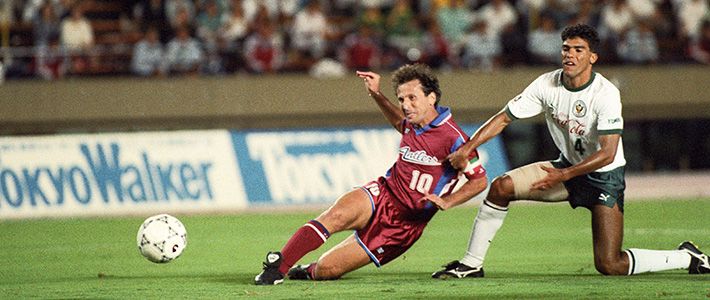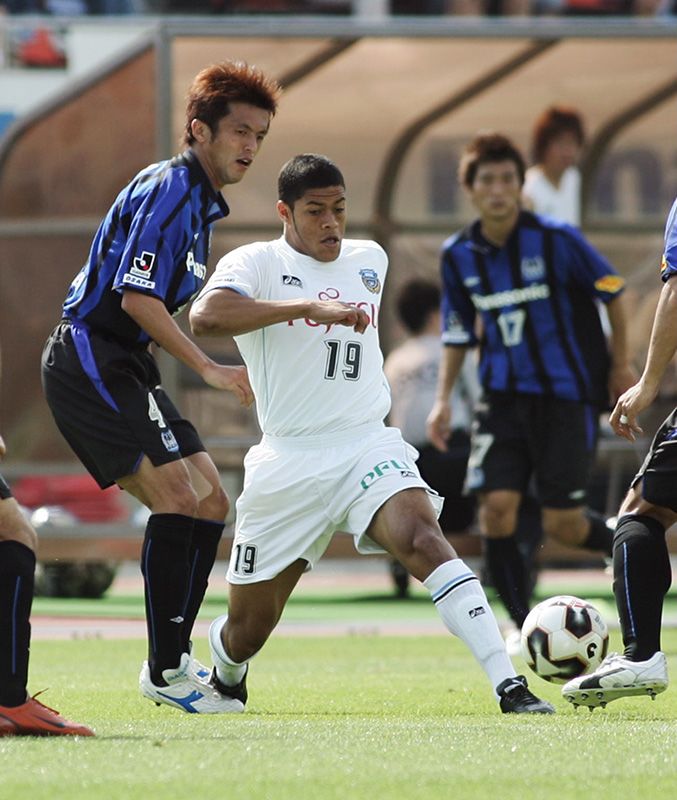
Brazilian Players: A Long Association with Japanese Soccer
Society Culture- English
- 日本語
- 简体字
- 繁體字
- Français
- Español
- العربية
- Русский
A Skill Level Unseen in Japan
The first Brazilian player in Japan was Nelson Daishirō Yoshimura, who came to play for Yanmar Diesel (now Cerezo Osaka) in 1967 at the age of 19. World-class Japanese striker Kamamoto Kunishige joined the squad in the same year, and together, the two helped transform Yanmar into one of the top teams in the country.
Back in Brazil, Yoshimura had been playing for an amateur team composed entirely of Japanese Brazilians. Although he was largely unknown in his home country, he brought with him a level of skill and technique previously unseen by the fans in Japan. Yoshimura became eligible to play for the national team when he took Japanese nationality in 1970. He continued to represent Japan until 1976, attracting much admiration for the traditional Brazilian emphasis on individual technique. He was followed at Yanmar by countrymen Carlos Esteves in 1969 and George Kobayashi in 1971, both of whom also made a big impact.
The first player to play in Japan on the back of professional experience in Brazil was former Corinthians midfielder Sérgio Echigo, who joined Towa Estate Development SC (now Shōnan Bellmare) for three years from 1972. His arrival sparked much debate in the all-amateur Japan Soccer League about the inclusion of former professional players. After he retired, with the financial backing of Coca Cola, Echigo set up a soccer academy for children that toured all over Japan, helping considerably to further popularize the sport.
Ruy Ramos (now coach of FC Gifu) came to Japan in 1977 and plied his trade at two previous incarnations of Tokyo Verdy, Yomiuri FC and Verdy Kawasaki. He took Japanese nationality in 1989 and became a core member of the Japanese national team, where he played until the mid-1990s.
A Titan Arrives in the J. League
Japan’s first professional soccer league, the 10-team J. League, was formed by the Japan Football Association in 1991. After a qualifying tournament the following year to determine the teams that would take part, the league’s official launch came in 1993, and by 1998 a full 18 pro teams had been founded. This sparked a major surge in the popularity of soccer in Japan, where it had until then been seen as a relatively minor sport. The boom took great impetus from the arrival of a titan of world soccer: In 1991, Sumitomo Metal Industries (soon to be reborn as one of the J. League’s founding teams, Kashima Antlers) secured the signature of Brazil legend Arthur Antunes Coimbra—better known as Zico.
Zico remained with the Antlers until he retired from playing in 1994, and his top-class skills and fastidious preparation made a big impression on the Japanese fans. In 2002, after a brief spell in club management both at Kashima and back home in Brazil, Zico was appointed coach of Japan’s national team. He remained in the role for four years, ultimately leading the team to the 2006 World Cup in Germany.
Zico was joined in the early years of the J. League by former international teammate Careca (who played for Kashiwa Reysol in 1993–96) and 1994 World Cup winning captain Dunga (Júbilo Iwata, 1995–98.) In fact, eight members of the Brazil squad who won the 1994 World Cup in the United States would play in the J. League at some stage, from Jorginho and Bebeto with the Antlers to Müller at Reysol. There was Alcindo, who banged in goals alongside Zico for the Antlers, and Leonardo, whose 1995 wonder strike in the Kashima colors is still talked about by fans to this day. Then there was Shimizu S-Pulse goalkeeper Sidmar, whose martialing of a watertight defense and command of the Japanese language made him a natural hit with the supporters.
 Alcindo goes on the offensive for the Kashima Antlers, 1993. (© Jiji Press)
Alcindo goes on the offensive for the Kashima Antlers, 1993. (© Jiji Press)
Brazil-Born Samurai in the World Cup Finals
 Brazil international player Hulk during his days at Kawasaki Frontale, 2005. (© Jiji Press)
Brazil international player Hulk during his days at Kawasaki Frontale, 2005. (© Jiji Press)
The Japan men’s international team made its first World Cup finals appearance in France in 1998. The squad went on to make a firmer impression on the world stage by making it to the round of 16 in the 2002 and 2010 tournaments. Brazilian-born players have at various stages played an integral part in this success.
In 1997, the Brazilian-born Bellmare forward Wagner Lopes, who had come to Japan 10 years earlier to play for the Nissan Motor team that would eventually become Yokohama F Marinos, took Japanese citizenship, a move that paved the way for him to represent Japan in France in 1998. His precedent was followed by wing back Alex Santos, who appeared in the 2002 and 2006 tournaments (after coming to Japan in 1994 at age 16), and central defensive pillar Tulio Tanaka (Nagoya Grampus), who took the field in all four of Japan’s World Cup matches in South Africa in 2010 and was instrumental in the team’s progress to the last 16.
There have also been Brazilian players whose international debut came after making a name for themselves in the J. League. One such individual, who will be pulling on the yellow shirt of Brazil at this year’s World Cup in his home country, is Hulk, who came to Japan with Kawasaki Frontale in 2005. He spent time on loan at Consadole Sapporo and Tokyo Verdy before moving to the heayweight Portuguese team FC Porto in 2008. The powerful forward earned his first full Brazil cap in 2009 as his goals helped Porto to a host of titles, including the 2010–11 Europa League. He also made a big money transfer to oil-rich Russian side Zenit St. Petersburg in 2012.
Continuing this longstanding trend, the 2014 season so far has also seen a host of Brazilian-born players active in the J. League, as well as two head coaches. The tactical knowhow and player-management skills of Nelsinho Baptista at Reysol and Toninho Cerezo at Antlers are helping to ensure that the competition retains a strong Brazilian influence, both on and off the pitch. Japan’s trip to the country for this summer’s World Cup may just serve to further deepen these ties.
Brazilian Internationals in Japanese Soccer
| Name | Position | World Cup Appearances | Club |
|---|---|---|---|
| Pepe | FW | 1958 1962 | 1992 Yomiuri (Coach) |
| Émerson Leão | GK | 1970 1974 1978 1986 | 1992–94 Shimizu (Coach) 1995–96 V. Kawasaki (Coach) 2005 Kobe (Coach) |
| Oscar | DF | 1978 1982 1986 | 1987–89 Nissan |
| Zico | MF | 1978 1982 1986 | 1991–94 Sumitomo/Kashima 1999 Kashima (Coach) 2002–6 Japan (Coach) |
| Toninho Cerezo | MF | 1978 1982 | 2000–2005 Kashima (Coach) 2013– Kashima (Coach) |
| Falcão | MF | 1982 1986 | 1994 Japan (Coach) |
| Silas | MF | 1986 1990 | 1998–99 Kyoto |
| Careca | FW | 1986 1990 | 1993–96 Kashiwa |
| Müller | FW | 1986 1990 1994 | 1995 Kashiwa |
| Dunga | MF | 1990 1994 1998 | 1995–98 Iwata |
| Jorginho | DF | 1990 1994 | 1995–98 Kashima 2012 Kashima (Coach) |
| Mozer | DF | 1990 | 1995–96 Kashima |
| Bismarck | MF | 1990 | 1993–96 V. Kawasaki 1997–2001 Kashima 2003 Kobe |
| Tita | MF | 1990 | 2001 Urawa (Coach) |
| Bebeto | FW | 1990 1994 1998 | 2000 Kashima |
| Gilmar | GK | 1994 | 1995–97 Cerezo Osaka |
| Ronaldão | DF | 1994 | 1994–95 Shimizu |
| Zinho | MF | 1994 | 1995–99 Yokohama Flügels |
| Leonardo | MF DF | 1994 1998 | 1994–96 Kashima |
| César Sampaio | MF | 1998 | 1995–98 Yokohama Flügels 2002 Kashiwa 2003–4 Hiroshima |
| Edmundo | MF | 1998 | 2001–3 Tokyo Verdy 2003 Urawa |
| Hulk | FW | 2014 | 2005 Kawasaki Frontale 2006 Sapporo 2007 Tokyo Verdy 2008 Kawasaki F, Tokyo V |
(Banner photo courtesy of Jiji Press.)
Soccer football World Cup Brazil sport J. League National Team